Kingston Cemetery
What We Know about the
Kingston New Mexico Cemetery
Kingston's Beginnings
Mining in the Kingston area began in 1882 after a rich vein of silver was located at the Solitaire Mine; that mine site can be found 3 miles up Forest Service Road 157. Sections of what became Kingston were first platted in August 1882 and were named for the the area’s Iron King mine. As miners and their families began to pour in, several more sections were platted, and the Kingston population increased rapidly.
One of Kingston’s early miners was Joseph Wittman. He was a veteran of the Civil War and a member of the Grand Army of the Republic (GAR) a group of Union veterans of the Civil War. It was the GAR members who established the Kingston cemetery in 1884 and fenced in its 10 acres. They included a special section for Civil War Veteran burials which can still be found today (#8 in our Guide below).
By 1908 Kingston’s population had dwindled drastically due to the devaluation of silver. The Forest Service took possession of the cemetery. A Special Use Permit was granted to the county commissioners of Sierra County, Hillsboro, New Mexico for the purpose of a cemetery by the US Forest Service, Gila National Forest on July 22 of that year. That permit continues today.
Fenced and protected for decades, the cemetery not only holds the memories of people who lived in the area but a memory of plants as well. With the addition of livestock to the west, many areas were heavily grazed in the late 1800s and early 1900s impacting the native plant communities. Cemeteries throughout the west hold within their fenced “exclosure” some information of the past. The Spit and Whittle Club of Kingston, one of the oldest social clubs in the west, is responsible for the maintenance of the cemetery. It’s members work to restore fencing, remove weeds from gravesites, and protect native plants that are still held within its fences.
If you have information about any person or family in the cemetery, please contact hillsboronmhistory@gmail.com to share the information with us. Every story is important to more understanding of area history. We thank you!
Directions to the Kingston Cemetery
Guided Route
1. Andrew Kelley ~ 1847-1919 and Cecilia Kelly ~ 1859 -1892
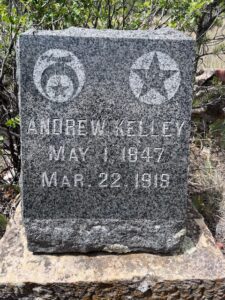
Andrew Kelley was born in Canada. He came to New Mexico about 1867 with the 15th Regiment of the US Regulars. He originally settled in Chloride, but eventually came to Kingston. He was a member of the Kingston Lodge #16 Ancient and Free Masons (AFAM) and the Third Scottish Rite. He became a US citizen at Socorro in 1875 and worked as a mason. He helped fight against an Indian uprising and later took on work as a Sierra County Clerk.

Cecilia Shepperd Kelley married Andrew Kelly on Sept 12, 1875. Their children were Cecilia M. Anderson (b. 1880) Agnes E. Sheppard (b 1882) Martin Luther (b. 1883) John Constantine (b. 1886) Frank William (b. 1877) and Phillip Sheridan (b. 1890).
There are three plaques just outside the rock enclosure. Two are readable: Agnes Elizabeth Sheppard, March 26, 1882 – March 1939 and William Foster Sheppard, July 9, 1900 – December 30, 1927. The third plaque, in the middle, was recorded as William Alfred Sheppard and is now illegible on site. William had a homestead on Percha Creek, which was washed out in the 1914 flood.
Note that the last name spelling differences are consistent with gravestones and plaques on the site.

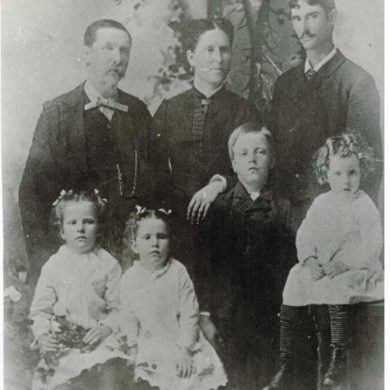
2. William M. "Sheba" Hurst ~ 1836 (est.) - 1911
Sheba was a miner in the early 1800s in Kingston. He died in Kingston on March 1, 1911, and was buried in this cemetery. He was immortalized as a character in Mark Twain’s Roughing It. A 1996 geological survey placed his grave near the “south cattle entrance.” It remains unmarked, as the original tombstone and a replacement grave marker were both stolen. Rusted steel marker #2 for this guide marks the general area where the grave is located.


3. John Wilson ~ 1850 - 1886
John and his brother came to Kingston during its early days in the 1880’s. He was a businessman and a miner who located the Solitare Mine. This was part of the rich mineral district in which Kingston is the center. He died fairly young at 35 years old. Notice the small child with the woman inside the walled gravesite in the photo below.
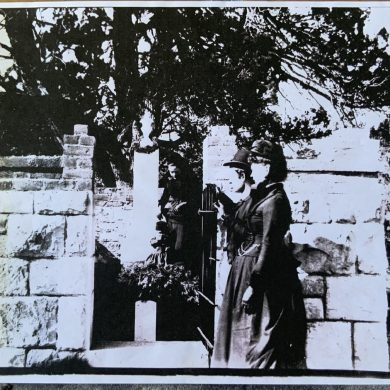
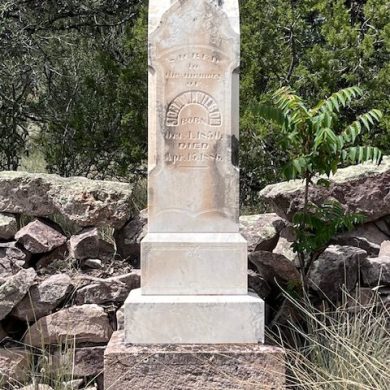
4 - 6. Charlie Clay, Robert West & Rand Holkeboer



4. Charlie W. Clay, 1872 – 1884. Charlie was just a boy when he died at the “12 years, four months and five days” as noted on his tombstone. His father Isaac Clay was a store owner in Kingston. This grave is one of four in the plot. It has a foot stone also. Like many graves in the cemetery, the others are marked by rocks and bricks.
5. Robert West, 1832 -1899. The West’s were one of Kingston’s wealthier families. There are two graves in this plot. The second grave belongs to Mamie West who died at age 10. She lived from 1878 – 1889. Robert and wife Ann are pictured below.
6. Rand Holkeboer, 1965 – 1991. This grave is marked with a Scandinavian-style wooden cross. Young Rand died in the mountains here while hiking. His remains were found the following spring.

7. Bernards, McCahons, Brownells and Jones

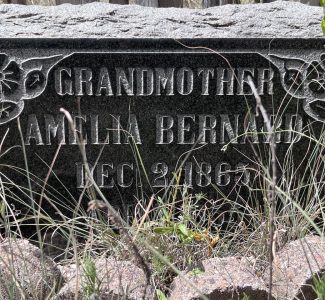

At #7 on the Guided Trail there are a number of graves of family members within the picket fence. What we know of this family is not extensive:
Samuel H Bernard 1862 – 1943 and “Grandmother” Amelia Bernard 1865 – 1955. Samuel and his wife Amelia arrived in Kingston in 1883. He was a miner, Justice of the Peace, precinct chair, and leader of the Spit and Whittle Club. Amelia was also known to all as “Granny.” Note Samuel’s is the official signature on W.M. Hurst death certificate above (#2.)
Rosie McCann. Rosie built the large adobe house in the middle 1930s that still stands on the northwest end of Main Street. Her son Sam McCann married Gertrude Brownell in 1938.
8. Civil War Section



This area within the Cemetery was established by Civil War Veterans of the Grand Army of the Republic. Here you will find the graves of the following people:
Simpson Percy Reid, 1845–1892. Percy was the first husband of Margaret Reid Armer (see the Reid-Armer Section #9 on this tour). Alvin Gage wrote in 1934, “he was an engineering expert of wide experience, operating mines and smelters, and was a recognized authority on smelting and refractory ores.” He died of typhoid fever during the 1892 epidemic in Kingston, leaving Margaret with six young children. Margaret’s grave is in the fenced, Reid-Armer section.
Frank D. Kennett, 1828–1906. Frank was a veteran of the Mexican and Civil Wars.
Thomas Holland (headstone with no dates). Thomas served in Louisiana Company C First Infantry.
Charles Walker, 1829–1903. Charles was also a veteran of the Mexican War.
As we find throughout the Cemetery, there are other unmarked graves in this section of the cemetery.
9. Reid-Armer Section




This large section of the Cemetery is enclosed by a chain-link fence. Gravesites include:
Margaret McEvoy Reid-Armer, 1864 – 1933. Margaret was a remarkable woman and became very well-known nationally for the Angora goats she raised. Margaret married Simpson Percy Reid in 1879 at the age of 16. They moved to Kingston from California during the silver boom. Alvin Gauge wrote that “the 16 year old bride dared the adventure into the wild mining country where… bands of Indians still made life hazardous on the semi arid range.”
Margaret married second husband Leven Edward Armer in 1894 two years after Percy’s death in 1892 from typhoid fever. Edward was a mining engineer from Louisville, Kentucky, and son of a paddlewheel steamboat captain. He came to Kingston as the result of the Silver boom. Edward died in 1902.
Percy is buried in the Civil War section of the cemetery, as noted in #8 above. Margaret and Percy had six children; she and Edward had three. Edward’s grave is reported to be in the Reid-Armer compound, but it is unmarked.
Margaret’s ranch, called the Saw Pit, was located on what is now Forest Service Road 157. The ruins are still visible there. After Percy Reid’s death, this young mother, still in her 20s, investigated the economics of raising Angora goats for mohair. She became a member of the Mohair growers association, becoming known as the Goat Queen. Her goats were driven off multiple time by local Native Americans, but she persevered and eventually had the best and largest flock of Mohair goats in New Mexico. She shipped their hair all over the United States and many awards.
The six Reid-Armer children walked a trail from their Saw Pit Ranch two miles over the hills to school in Kingston. They also sold goat milk to local residents. This trail can still be found north of Kingston. Margaret and Percy’s son, Robert Reid and his wife Mary homesteaded on North Creek in 1917. Mary wrote “the road is overlapped from each side with big Oak and Maple trees … There were seven running springs and an old orchard and a wonderful garden spot.” Mary and Robert ultimately ran 4000–5000 goats of Margaret’s herd over 35,000 acres of the Gila National Forest, state and private land.
Of Margaret’s nine children, six are buried here: Joseph W Reid (1880-1946), Henrietta Reid Wilton (1882-1938), Robert Whiteside Reid (1884 – 1971) with Mary Sparks Reid on one headstone, Thomas B. Reid (1889–1942), Simpson G. Reid (1891–1950), and Eddie Armer (1900–1905). Eddie was the third child of Margaret and Edward Armer; he died of a concussion from a fall. Margaret’s father Joseph McEvoy, 1828–1902, is also buried in this plot.
Nicholas Tarcia, 1863–1952. Nicholas was Russian; he was a goat-herder who worked on the Reid-Armer ranch. He owned a small mine in the area, and was known for his beautiful singing voice.
10. James Drummond ~ 1848 -1937 & Bel Drummond ~ 1858 -1947



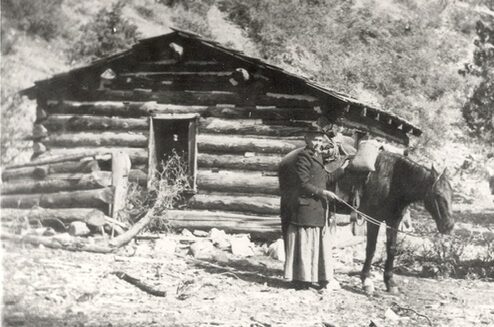
James and Bel Drummond came to Kingston from Strongsville Ohio in the early 1880s. James owned and worked the Gray Eagle mine. They had a very comfortable life and were said to be very generous towards their neighbors. Bel wrote letters for neighbors and gave money to some who were needy.
in 1908 Kingston’s population had drastically declined due to the devaluation of silver. Many properties were abandoned. These properties could be claimed by publishing a notice in the newspaper for three weeks. If no one contested the claim it was awarded to the claimant. In this way, the Drummonds acquired the house that was previously owned by William Dawson, a long time Kingston druggist. They apparently did a lot of gardening in the “Chinese Gardens,” part of which was behind their house. This private home still exists at the east end of Kingston.
11. James McNally ~ 1838-1904
James McNally was a Congressional Medal of Honor recipient. He served in the third and eighth US Cavalry from 1858–1883. He was wounded during the Civil War battle of Valverde, New Mexico on February 21, 1862. After his final discharge, McNally lived in Hatch, Hillsboro and Kingston, where he worked several mining claims. He died in Kingston on November 26, 1904. First Sergeant James McNally was presented the Nations highest award for valor for his bravery as a scout and for his role in the fight against “Indians during 1868 and 1869 while serving with Company E, 8th U.S. Cavalry, in action at Arizona Territory.” The specific location of his grave is debated, but he was noted to have lived in Kingston until he died.
For more about the two Congressional Medal of Honor recipients with markers in our cemeteries go to : Medal of Honor Markers

Unmarked Burial Sites
The west side of the Kingston Cemetery was used for early burials. We assume that many of the graves were marked with wooden crosses or boards with identifying information. Unfortunately, these markers no longer exist, and the identities of individuals buried in specific sites remain unknown. Honoring this, the west side of the cemetery is no longer used for burials.
There is a continuing effort by local historians to identify as many people buried in this and other sections of the cemetery as possible. Much of the information is vague. Through ongoing research, including articles which appear in the Silver City Enterprise from 1882 to 1892, we have been able to identify some of these people.


One example of an unmarked grave in the Kingston NM Cemetery is Richard Heel – the man in the photo to the left. We have not found a grave marker for Richard.
Text of note below the photo:
“Richard Heel “Uncle Dick” posing for a picture in front of boarding house of Moffit Mining and Milling on south Percha Creek. I never knew of him having a regular job about Kingston. He always hung around gambling halls and saloons and depended on those patrons for his livelihood. Johnnie Moffit took care of him during his latter years. He was watchman for him up the mines when this picture was taken. He was found several days after his death alone, in Moffits home … off from the north end of Main Street in Kingston, N.M. Not known exactly the time of his death. He was buried in the Kingston Cemetery. Taken 1921.”
Additional Historical Notes
Sadie Orchard, 1859-1943. Although she is not buried in the Kingston Cemetery, Sadie has become legendary in the history of Southwestern New Mexico. She purportedly came to Kingston in 1886 as a prostitute, but soon ascended to management. She moved to Hillsboro in 1893 where she married the owner of the regional stagecoach line, J. W. Orchard. She also established herself as a successful hotel business woman. Though always tainted by her past, she eventually became a respected citizen. Much of the Sadie Orchard story has been reduced to fable. Many pieces of the legend arise from her own pretensions and fabrications, including the widely held belief that she was born in England rather than Iowa. Sadie is buried in Truth or Consequences, New Mexico.
The Hillsboro Historical Society has an excellent biography published titled Sadie Orchard – Madam of New Mexico’s Black Range, written by historian Garland Bills. This book is available in our store at the Black Range Museum.
Chinese Gardens. Around 1879, hundreds of Chinese were employed in the construction of the Southern Pacific Railroad through Arizona. When the railroad construction was completed, all the Chinese labors were dismissed. Many managed to settle in nearby towns, finding work in the mines or in the service industry. Chinese residents of Kingston are identified in photos in the archives of the Palace of the Governors archives, attributed to J.C. Burge, 1885–1886. The 1888 Sierra County tax role for Kingston lists Lee Fook as owning two houses and a garden. A plated map of Kingston from the 1930s includes the historical designation of the “Chinese Gardens” located along Middle Percha Creek. Two Chinese-owned businesses were “Chinese Curiosities” and a laundry/bath house existed on Main Street.
It is not known whether there were any burials of Chinese individuals in the Kingston cemetery. Chinese of the era believed in sending their remains to their birthplace.
Cemetery Graves, Locations and Information
This map is presented for reference and locating graves. Numbers on the mapped gravesites shown correspond to the List of Graves by Surname document above.
For More Information
An excellent free website for extensive grave information and photos: https://www.findagrave.com/
We thank Barbara Lovell for the valuable research into the people who lived in Kingston during its early days. For more on Kingston history, plan a visit to Kingston!
Kingston Ghosttown Museum, 28 Kingston Main St, Kingston, NM 88052.
Hours – Saturday 10:30-4 and Sunday 12-4
Phone – 575-579-3064. email Barb Lovell at: kingstongtmuseum@gmail.com
